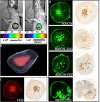Necrosis avid near infrared fluorescent cyanines for imaging cell death and their use to monitor therapeutic efficacy in mouse tumor models
- PMID: 26472022
- PMCID: PMC4770755
- DOI: 10.18632/oncotarget.5498
Necrosis avid near infrared fluorescent cyanines for imaging cell death and their use to monitor therapeutic efficacy in mouse tumor models
Abstract
Quantification of tumor necrosis in cancer patients is of diagnostic value as the amount of necrosis is correlated with disease prognosis and it could also be used to predict early efficacy of anti-cancer treatments. In the present study, we identified two near infrared fluorescent (NIRF) carboxylated cyanines, HQ5 and IRDye 800CW (800CW), which possess strong necrosis avidity. In vitro studies showed that both dyes selectively bind to cytoplasmic proteins of dead cells that have lost membrane integrity. Affinity for cytoplasmic proteins was confirmed using quantitative structure activity relations modeling. In vivo results, using NIRF and optoacoustic imaging, confirmed the necrosis avid properties of HQ5 and 800CW in a mouse 4T1 breast cancer tumor model of spontaneous necrosis. Finally, in a mouse EL4 lymphoma tumor model, already 24 h post chemotherapy, a significant increase in 800CW fluorescence intensity was observed in treated compared to untreated tumors. In conclusion, we show, for the first time, that the NIRF carboxylated cyanines HQ5 and 800CW possess strong necrosis avid properties in vitro and in vivo. When translated to the clinic, these dyes may be used for diagnostic or prognostic purposes and for monitoring in vivo tumor response early after the start of treatment.
Keywords: cancer; cell death; cyanines; imaging; necrosis avid contrast agents.
Conflict of interest statement
The authors have no conflicts of interest to declare.
Figures






References
-
- de Bruin EC, Medema JP. Apoptosis and non-apoptotic deaths in cancer development and treatment response. Cancer treatment reviews. 2008;34:737–749. - PubMed
-
- Venkatramani R, Wang L, Malvar J, Dias D, Sposto R, Malogolowkin MH, Mascarenhas L. Tumor necrosis predicts survival following neo-adjuvant chemotherapy for hepatoblastoma. Pediatric blood & cancer. 2012;59:493–498. - PubMed
-
- Hiraoka N, Ino Y, Sekine S, Tsuda H, Shimada K, Kosuge T, Zavada J, Yoshida M, Yamada K, Koyama T, Kanai Y. Tumour necrosis is a postoperative prognostic marker for pancreatic cancer patients with a high interobserver reproducibility in histological evaluation. British journal of cancer. 2010;103:1057–1065. - PMC - PubMed
-
- Kato T, Kameoka S, Kimura T, Tanaka S, Nishikawa T, Kobayashi M. p53, mitosis, apoptosis and necrosis as prognostic indicators of long-term survival in breast cancer. Anticancer research. 2002;22:1105–1112. - PubMed
-
- Maiorano E, Regan MM, Viale G, Mastropasqua MG, Colleoni M, Castiglione-Gertsch M, Price KN, Gelber RD, Goldhirsch A, Coates AS. Prognostic and predictive impact of central necrosis and fibrosis in early breast cancer: results from two International Breast Cancer Study Group randomized trials of chemoendocrine adjuvant therapy. Breast cancer research and treatment. 2010;121:211–218. - PMC - PubMed
Publication types
MeSH terms
Substances
LinkOut - more resources
Full Text Sources
Other Literature Sources
Medical

